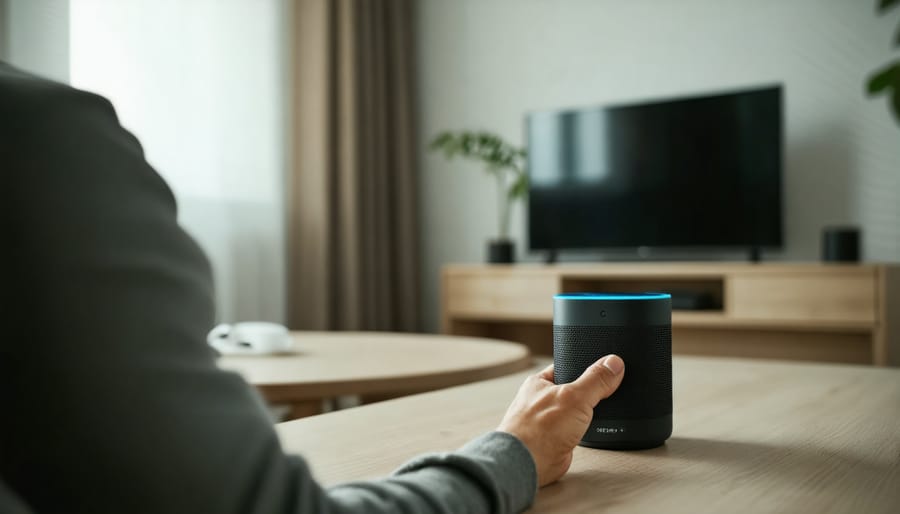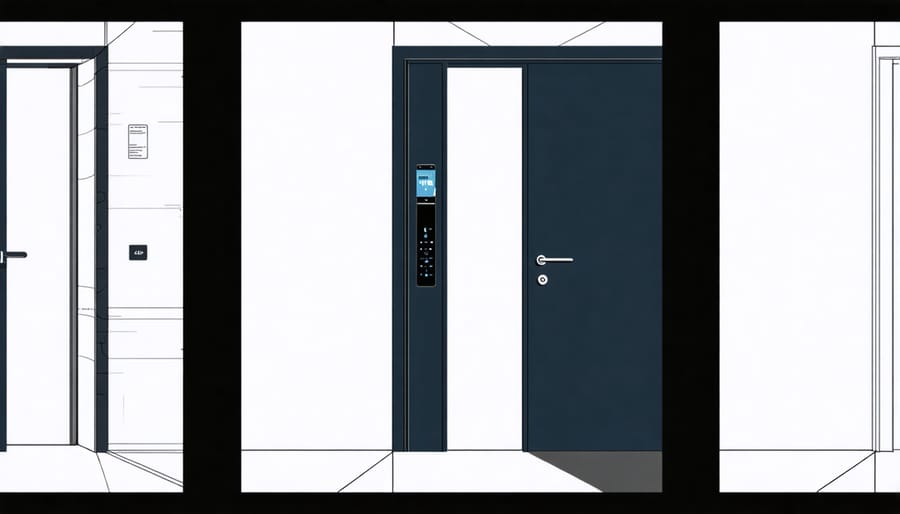Transform your home into an accessible haven with smart technology that empowers independence and enhances quality of life for persons with disabilities. Voice-controlled systems like Amazon Alexa or Google Home serve as the foundation for maximizing small living spaces while providing hands-free control over lighting, temperature, and security systems.
Modern smart home solutions have revolutionized accessibility, offering everything from automated door openers and remote-controlled window blinds to intelligent medication reminders and fall detection systems. These technologies not only enhance safety and independence but also seamlessly integrate into existing home setups without requiring major renovations or modifications.
What makes today’s smart home technology particularly powerful for individuals with disabilities is its unprecedented customization potential. Whether addressing mobility challenges, visual impairments, or cognitive disabilities, these systems can be tailored to meet specific needs while maintaining dignity and promoting self-sufficiency. The combination of affordability, ease of installation, and voice-first design makes these solutions more accessible than ever before.
Voice-Controlled Solutions for Enhanced Independence
Smart Speakers and Home Hubs
Smart speakers and home hubs serve as the central command center for a smart home, making them particularly valuable for individuals with disabilities. These compact devices, like the Amazon Echo or Google Nest Hub, can control multiple smart devices through simple voice commands, eliminating the need for physical interaction with switches, remotes, or smartphones.
For someone with limited mobility or visual impairments, being able to say “Turn on the lights” or “Lock the front door” provides unprecedented independence. Most smart speakers can manage everything from thermostats and lighting to security systems and entertainment devices. They can also set reminders for medications, make phone calls during emergencies, and provide audio information about the weather or daily schedules.
The latest models offer enhanced accessibility features like visual displays for those who are hard of hearing and specialized voice profiles that better understand speech patterns affected by disabilities. Many smart speakers can also integrate with medical alert systems and other assistive technologies.
When setting up a smart speaker, place it in a central location where voice commands can be easily heard from multiple rooms. Consider having additional units in bedrooms or bathrooms for complete coverage. Remember to customize voice commands to be simple and intuitive, making them easier to remember and use in daily routines.

Voice-Activated Lighting and Climate Control
Voice-activated systems have revolutionized how people with mobility challenges interact with their home environment. By integrating smart lighting design and climate control features, residents can easily manage their comfort without physical interaction with switches or thermostats.
Popular voice assistants like Amazon Alexa, Google Assistant, and Apple’s Siri can be configured to control multiple aspects of your home environment. Simply say commands like “turn on the bedroom lights” or “set temperature to 72 degrees” to make instant adjustments. These systems can be particularly beneficial during nighttime hours or when movement is challenging.
For enhanced accessibility, consider installing motion sensors that automatically activate lights in frequently used areas. Smart thermostats learn your temperature preferences throughout the day and can automatically adjust based on your schedule. Many systems also offer smartphone app control as a backup option.
To maximize effectiveness in small spaces, opt for multi-functional devices that combine lighting and climate control features. Smart LED bulbs with color-changing capabilities can create different atmospheres while using minimal space. Zone-based heating and cooling systems allow for personalized comfort in different areas without the need for multiple control units.
For easier installation and maintenance, choose wireless systems that don’t require extensive wiring or structural modifications. This approach keeps your space organized while ensuring full functionality of your voice-activated controls.
Automated Systems for Better Accessibility
Smart Door and Window Solutions
Smart doors and windows have revolutionized home accessibility, making daily life easier for people with mobility challenges. Automated entry systems now come in compact designs that work perfectly even in smaller spaces, offering both convenience and enhanced security.
For doors, smart locks with keyless entry options allow users to unlock their homes through smartphone apps, voice commands, or fingerprint recognition. Some systems even feature automatic door operators that can be retrofitted to existing doors, opening them smoothly at the touch of a button or through motion sensors. These operators are particularly helpful for wheelchair users and those who have difficulty gripping traditional doorknobs.
Window automation has also become more sophisticated and space-efficient. Modern smart window controls let you manage natural light and ventilation without physical effort. Remote-controlled window operators can be installed on most existing windows, allowing users to open, close, and adjust them from a central control panel or smartphone app. Some systems even include rain sensors that automatically close windows when bad weather strikes.
For added convenience, these smart solutions can be integrated with virtual assistants like Alexa or Google Home, enabling voice-controlled operation. You can create custom routines, such as automatically opening curtains in the morning or securing all entry points at night with a single command.
When choosing smart door and window solutions, consider options that offer backup power systems and manual override capabilities for emergencies. Look for products with quiet operation and smooth movements to minimize disruption and ensure comfortable use. Many manufacturers now offer professional installation services, though some systems are designed for straightforward DIY setup.

Space-Saving Security Features
Modern security doesn’t have to eat up valuable living space, thanks to innovative smart home solutions that pack powerful protection into compact designs. For those with mobility challenges or limited space, wireless security cameras no larger than a deck of cards can be mounted high in corners or on shelves, providing comprehensive coverage without creating obstacles.
Door sensors and smart locks have evolved to be remarkably slim, sitting flush with door frames and eliminating the need for bulky traditional deadbolts. Many of these devices can be controlled through voice commands or smartphone apps, making them ideal for users with limited dexterity or reach.
Motion sensors have also become increasingly sophisticated while shrinking in size. Today’s models are about the size of a small smoke detector and can distinguish between pets and people, reducing false alarms while maintaining security. These can be strategically placed on walls or ceilings, preserving valuable floor and surface space.
For visual alerts, LED light strips can be integrated along baseboards or door frames, providing emergency signaling without taking up any additional space. These can be programmed to change colors based on different security triggers, making them especially helpful for users with hearing impairments.
Smart doorbells with built-in cameras now come in sleek, low-profile designs that don’t protrude from door frames. Many include features like two-way audio and night vision, offering comprehensive entry monitoring without compromising accessibility or aesthetics.
Consider using multi-purpose devices that combine security features with other smart home functions. For example, smart speakers can double as glass-break sensors, while smart lighting can serve both daily illumination needs and security purposes, maximizing functionality in limited spaces.
Mobile-First Control Systems
Centralized Control Apps
Managing multiple smart devices becomes effortless with centralized control apps, which act as command centers for your entire smart home setup. These user-friendly applications bring all your connected devices together on a single dashboard, making it easier for people with disabilities to control their environment.
Popular options like Apple HomeKit, Google Home, and Amazon Alexa offer intuitive interfaces that can be customized to meet specific needs. For instance, you can create custom scenes that adjust multiple devices with a single command – imagine saying “Good Morning” to automatically open blinds, adjust lighting, and start the coffee maker.
What makes these apps particularly valuable is their compatibility with accessibility features built into smartphones and tablets. Voice control, switch access, and screen readers work seamlessly with these platforms, ensuring that users with different abilities can navigate and control their smart home efficiently.
Many of these apps also support caregiver access, allowing family members or support workers to assist remotely when needed. You can set up different access levels and customize controls based on individual needs and capabilities.
The real game-changer is the ability to create automated routines. These can trigger specific actions based on time, location, or other smart device activities, reducing the need for manual intervention. For example, motion sensors can automatically turn on lights and adjust thermostats as someone moves through the home, making daily activities more manageable and independent.
Custom Automation Routines
Custom automation routines can transform daily activities into seamless experiences for individuals with disabilities. By combining different smart devices into coordinated sequences, you can create personalized solutions that address specific needs and challenges.
Start by identifying regular daily activities that could benefit from automation. For example, a morning routine might integrate automated lighting control systems with motorized blinds, temperature adjustment, and voice-activated news briefings. This helps create a gentle, stress-free wake-up experience.
For mobility challenges, consider creating routines that prepare spaces in advance. A “coming home” sequence could automatically unlock doors, turn on lights, adjust thermostats, and even start kitchen appliances, all triggered by your smartphone’s location or a simple voice command.
Safety-focused routines are equally important. Set up nighttime sequences that ensure all doors are locked, security systems are armed, and pathway lighting is activated. For emergency situations, create one-touch routines that flash lights, contact caregivers, and unlock entry points for first responders.
Remember to test and refine these routines regularly, gathering feedback from users to ensure they truly enhance independence and comfort. Start with simple sequences and gradually add complexity as needed, always prioritizing reliability and ease of use over technical sophistication.

Smart Storage and Organization Solutions
In today’s smart homes, intelligent storage solutions are revolutionizing how individuals with disabilities organize and access their belongings. Modern space-saving storage solutions combine technology with thoughtful design to create more independent living spaces.
Voice-controlled cabinets and drawers have become game-changers for those with limited mobility. These systems respond to simple commands, smoothly opening and closing storage spaces without requiring physical effort. Some models even include height-adjustable shelving that can be lowered or raised through smartphone apps or voice commands, making previously unreachable items easily accessible.
Smart closet systems now feature motion-sensor lighting that automatically illuminates when approaching, helping those with visual impairments navigate their storage spaces more confidently. Pull-down wardrobe rods and motorized clothing carousels bring items within reach, while RFID-tagged items can be easily located through connected apps that tell you exactly where things are stored.
In the kitchen, pull-out pantry systems with automated mechanisms make accessing food items and cooking supplies easier. Smart organization apps can track inventory and even create shopping lists based on what’s running low. For medications and essential items, smart storage containers with scheduled alerts ensure nothing is forgotten or misplaced.
Bathroom storage has also been transformed with humidity-sensing cabinets that automatically ventilate to prevent mold growth, and smart medicine cabinets that can remind you when it’s time to take medications. These features are particularly helpful for individuals who might struggle with traditional storage systems or need additional prompts for daily routines.
The key to successful implementation is customization. Each solution can be tailored to meet specific needs, whether it’s adjusting height requirements, programming voice commands, or setting up personalized reminder systems. When combined with other smart home features, these storage solutions create a more accessible and empowering living environment.
Smart home technology has revolutionized accessibility for persons with disabilities, transforming living spaces into more independent and empowering environments. Through voice-controlled systems, automated routines, and intelligent sensors, individuals with various disabilities can now navigate their homes with greater ease and confidence.
The impact extends beyond basic convenience – it’s about dignity, independence, and quality of life. Smart home solutions have proven particularly valuable in smaller living spaces, where traditional accessibility modifications might be challenging to implement. These technologies maximize functionality without compromising precious square footage, offering elegant solutions that benefit both residents and caregivers.
Looking ahead, the future of accessible smart home technology is incredibly promising. Artificial intelligence and machine learning continue to evolve, leading to more intuitive and personalized accessibility solutions. We’re seeing the development of more affordable options, making these life-changing technologies available to a broader audience. Integration between different smart devices is becoming seamless, creating comprehensive support systems that adapt to individual needs.
As manufacturers increasingly prioritize universal design and accessibility features in their products, we can expect even more innovative solutions. The key will be maintaining the balance between technological advancement and user-friendly implementation, ensuring that these tools remain accessible to those who need them most.
Remember, creating an accessible smart home is an ongoing journey rather than a destination. Start small, focus on your specific needs, and gradually build a system that works for you.
